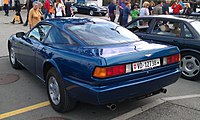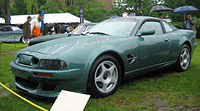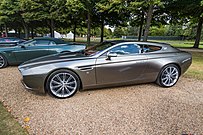Aston Martin Virage
It has been suggested that this article should be split into a new article titled Talk:Aston_Martin_Virage#Separate_and_split_Virage's_year_2010. (discuss) (April 2024) |
| Aston Martin Virage | |
|---|---|
Grand Tourer (S) | |
| Chronology | |
| Predecessor | Aston Martin V8 Vantage (1977) |
| Successor | |
The Aston Martin Virage is an
The V8-powered model was intended as the company's flagship model, with the 6-cylinder
A new Virage model was introduced at the 2011 Geneva Motor Show, to fit into the middle of Aston Martin's then current lineup but was discontinued in 2012 due to many similarities between the brand's other models.
Virage (1989–2000)
Virage/V8 Coupe and Works Service models
| Virage | ||
|---|---|---|
Kerb weight | 1,790 kg (3,946 lb) | |
When compared to the preceding
provided the steering column, climate control panel, wing mirrors and dash switches. In fact, Ford had purchased Aston Martin and Jaguar shortly before the Virage debuted and it became the first model to be introduced under the new ownership.The Virage was a large, heavy car in spite of its all-aluminium body, but the 32-valve 5.3 L (5,340 cc) V8 engine's 494 N⋅m (364 lb⋅ft)
.The five-speed
-
Aston Martin Virage engine bay
-
Interior
-
Rear 3/4 view
Works Service
-
Aston Martin Virage 6.3 Widebody (Works Service)
In January 1992, Aston Martin introduced a conversion service, upgrading the car into a Virage 6.3. As the name implies, the centerpiece of the conversion was a bored and stroked 6.3 L (6,347 cc) V8 derived from the AMR1 racing car. This engine has a power output of between 456 and 500 hp (340 and 373 kW; 462 and 507 PS) at 6,000 rpm and 480 lb⋅ft (651 N⋅m) of torque at 5,800 rpm, allowing the car to attain a top speed of 175 mph (282 km/h).
Other changes included 14-inch (356 mm) ventilated disc brakes, the largest used in a passenger car until the Bentley Continental GT, and 18 inch wheels. Visually, the 6.3 had wide flared bumpers, low sills and air dams, and side air vents.
- Virage Shooting Brake
A
- Lagonda Virage Saloon
-
A sketch showing the side profile of the Lagonda Virage saloon
The
- Lagonda Virage Shooting Brake
The five-door Lagonda Virage Shooting Brake debuted at the same time as the Lagonda Virage. It was made by Aston Martin Works Service in only one or two examples, and has been spotted bearing "Vacances" badging at the rear. A further six cars were made for a royal family from the ground up, adding a 406.4 mm (16 in) extension to the chassis of a standard Virage.[11]
V8 Coupe
A less extreme (compared to the Vantage) V8 Coupe replaced the standard Virage from 1996 onwards having the updated styling inherited from the more powerful Vantage. Lacking the superchargers and the more aggressive body style of its sibling, the engine in the V8 Coupe has a power output of 350 hp (261 kW; 355 PS)[12] and 369 lb·ft (500 N·m) of torque.[13][14] In total, 101 examples of the V8 Coupe were built from 1996 through 2000.
- V8 Sportsman Estate
The V8 was also subject to coachbuilt conversion by Aston Martin's Works Service department. Dubbed the Sportsman estate, only three were made using existing V8 Coupes as a base. No mechanical modifications were made and the Estate retained the V8 Coupe's engine and mechanicals.[15]
-
Aston Martin V8 Coupe
-
rear 3/4 view
Virage Volante/V8 Volante
| Virage/V8 Volante | |
|---|---|
Torqueflite automatic | |
| Dimensions | |
| Wheelbase |
|
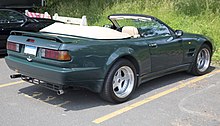
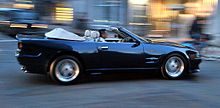
The convertible version of the Virage, called the Virage Volante debuted at the 1990
1992 was also when Aston Martin introduced its 6.3-litre "Works Service" package, which included wider fenders to accommodate the larger OZ wheels and 14-inch disc brakes, additional vents, deeper sills, and other appearance modifications. This was immediately available on the Coupé as well as the Volante.[16] Aston Martin soon introduced a strictly cosmetic version called the Wide Body featuring the regular 5.3-litre engine; this was mainly intended for the United States market as the 6.3 was not certified for sale there. 13 of these were built for the United States, whereas only seven regular Virage Volantes were delivered there. In contrast to the Wide Body Volante, the Prince of Wales chose to equip his 1994 Volante with the standard bodywork coupled with the 456 hp (340 kW; 462 PS) 6.3-litre engine and a manual transmission.[17]
A new V8 Volante Long Wheelbase, with updated styling of the V8 Coupe was produced from 1997 to 2000 on a chassis lengthened by 200 mm (7.9 in). Only 63 units were built by the time production came to a halt.
Following on their V8 Volante junior car, Aston Martin built a half-scale junior car version of the Virage Volante as well. It received a handmade aluminium body, leather interior, and a 160-cc Honda engine; this children's car cost as much as a brand new Mercedes-Benz 190E.[18] Ten examples were built in total.
Vantage
| Vantage/Le Mans | |
|---|---|
twin-supercharged V8 | |
| Transmission | 6-speed ZF manual |
As with many other Aston Martin models, a high-performance Vantage model of the Virage would later be introduced. First shown at Birmingham in September 1992, the Vantage was produced from 1993 through 2000 and, like many other Aston Vantage models would soon become the only variant available. The Virage name lasted just a few years, with its final descendants inheriting the simple and familiar V8 name.
The Vantage had new styling with only the roof, doors and wing mirrors shared with the Virage. The wing mirrors were later replaced in favour of the ones from the Jaguar XK8/XKR. The Vantage is wider, lower, used four round tail lights (later adopted for the base V8 Coupe), and featured new rear suspension and interior electronics. Like the 6.3, the Vantage used record-sized 362 mm (14 in) brake discs and 18 inch wheels.[8]
The biggest change to the Vantage was inside the engine compartment. The 5.3 L (5,341 cc) V8 engine now used twin superchargers. Power output was now 550 hp (410 kW; 558 PS), and the torque was equally high at 555 lb⋅ft (752 N⋅m) at 4,000 rpm. Top speed was 300 km/h (186 mph), with acceleration to 97 km/h (60 mph) taking 4.6 seconds.[8] Customers cars could be returned to Works Service starting in 1998 to be converted to V600 specifications, where the engine was upgraded to 600 hp (447 kW; 608 PS) at 6,200 rpm and 600 lb⋅ft (813 N⋅m) of torque at 4,400 rpm.[19]
In 2000, Aston Martin's Works Service unit also built nine bespoke Vantage Volante models (convertibles), one of which was built to long wheelbase specifications.[citation needed]
-
Vantage V600
-
Rear 3/4 view of Vantage V600
-
Engine compartment
-
Vantage Le Mans
V8 Vantage Le Mans
The new European emission and safety regulations made Aston Martin decide to end production of the V8-Vantage line and the final model was called "V8 Vantage Le Mans". Honoring Aston Martin's 1959 victory at the 24 Hours of Le Mans, the prototype of a limited run of 40 was presented in Geneva in 1999 on the 40th anniversary of the win.
All Le Mans Vantages were sent back after delivery to have the engine modifications to deliver 612 PS (450 kW; 604 hp) and 820 N⋅m (605 lbf⋅ft) of torque, and were supported by a suspension reinforced with special Koni shock-absorbers and stiffer anti-roll bars. The bodywork featured a blanked-out front grille and modified side vents – replicating the side vents of the Le Mans winning DBR-1 – as well as a bigger front spoiler and rear skirt.[20] The interior was reworked with a large rev-counter, a special Titanium finish on some parts, and features such as heated windshield, parking radars, traction control, heated electric seats, and full Connolly leather upholstery with matching Wilton wool carpets. Wheels were the same Dymag magnesium units as seen on most V600s. Performance included a claimed top speed of 320 km/h (199 mph) and 0 to 100 km/h acceleration being achieved in 3.9 seconds. The keyholder was in sterling silver and a map from Newport-Pagnell to the legendary Le Mans track was provided in the delivery documents. Each car was made upon special commission and fitted with a number plate indicating also the name of the first owner.[21]
US availability
The Virage would not become available in the United States until the summer of 1990 and the Virage Volante convertible became available later in 1992. The later V8 Coupe version and the Virage Vantage were not officially offered for sale in the US. Availability was ended after the 1993 model year, due to the lack of passenger airbags and inability to meet emissions regulations.[22]
Virage (2011–2012)
| Virage | ||
|---|---|---|
Kerb weight 1,740 kg (3,836 lb)[24] | | |
A new generation of the Virage was introduced at the
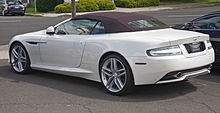
The car has a 2-seat or 2+2 seating configuration. The Virage's 5.9-litre AM11 V12 engine has a power output of 497 PS (365 kW; 490 hp) and 570 N⋅m (420 lb⋅ft) of torque. It is capable of accelerating from 0 to 100 km/h (62 mph) in 4.6 seconds, and has a top speed of 300 km/h (186 mph),[26] while the Virage Volante is limited to 295 km/h (183 mph).[27] The Virage was available in two bodystyles: Coupé or Volante (convertible).[28][29]
2014 Aston Martin Virage Shooting Brake Zagato Centennial
In September 2014, Zagato revealed a one-off shooting brake at the Chantilly Arts & Elegance Concours d’Elegance. The car is based on the Aston Martin Virage. It was commissioned by a European client. It follows the same design cues as the Aston Martin DBS Coupe Zagato Centennial and Aston Martin DB9 Spyder Zagato Centennial.[30]
-
Virage Shooting Brake Zagato
-
Front detail
References
- ^ ISBN 3-444-00514-8.
- ^ a b McCourt, Mark J. (November 2016). "1991–1992 Aston Martin Virage". Hemmings. Retrieved 9 February 2019.
- ^ a b "Virage". Aston Martin. Retrieved 9 February 2019.
- ^ "Virage". Autocar & Motor: 29. 15 August 1990.
- ^ a b Söderlind, Alrik (2 May 1991). "Brustna illusioner" [Broken illusions]. Teknikens Värld (in Swedish). Vol. 43, no. 9. Stockholm, Sweden: Specialtidningsförlaget AB. pp. 8–9.
- ^ ISBN 3-444-10479-0.
- ^ "1990 Aston Martin Virage in "The Driven Man, 1991"". IMCDb. Retrieved 9 January 2023.
- ^ a b c Automobil Revue 1997, p. 153
- ^ "Virage Shooting Brake in Aston Martins.com". AstonMartins.com. Retrieved 21 March 2015.
- ^ "Virage Lagonda 4 Door Saloon (1994)". astonmartins.com. Retrieved 15 July 2020.
- ^ "Virage Lagonda 5-door Shooting Brake". Retrieved 9 February 2019.
- ^ "V8 Coupe LWB Volante". www.astonmartin.com. Retrieved 20 June 2023.
- ^ "1996 Aston Martin V8 Coupe". Bonhams. 19 May 2019. Retrieved 15 July 2020.
- ^ Ramey, Jay (16 May 2019). "Rare Aston Martin V8 Coupe heads to auction". Autoweek. Retrieved 15 July 2020.
- ^ Perez, Jeff (27 April 2017). "Rare 1996 Aston Martin V8 Estate Is Better Than Any SUV". Motor 1. Retrieved 15 July 2020.
- ^ "1993 Aston Martin Virage Volante 'Wide Body'". Monterey, CA: RM Sotheby's. 15–17 August 2019. Lot 118. Archived from the original on 8 August 2019.
- ^ Wakefield, Steve (10 May 2012). "Driven: Aston Martin Virage Volante 6.3-Litre". Classic Driver. Archived from the original on 26 August 2014.
- ^ Johansson, Claes; Fröberg, Jonas (16 May 1991). "Salongsberusning" [Salon drunk]. Teknikens Värld (in Swedish). Vol. 43, no. 10. Stockholm, Sweden: Specialtidningsförlaget AB. p. 15.
- ^ Orlove, Raphael (7 November 2014). "When Aston Martin Built The Most Powerful (And Stupid) Car In The World". Jalopnik. Gizmodo Media Group. Retrieved 11 July 2020.
- ^ "2000 Aston Martin Vantage Le Mans 'V600' Coupé". RM Sotheby's. 25 May 2019. Retrieved 11 July 2020.
- ^ Easthope, Alex (27 October 2017). "The Aston Martin Le Mans V600 is a Jurassic monster with a bone-breaking punch". Classic Driver. Retrieved 11 July 2020.
- ^ Mateja, Jim (22 June 1997). "DB7 is a shout from long-hushed Aston Martin". Chicago Tribune.
- ^ Howe, James (15 June 2023). "Aston Martin V12 engine tech guide". Prestige and Performance.
- Car & Driver. Retrieved 9 February 2019.
- ^ Ramsey, Jonathon (4 September 2012). "Aston Martin Virage discontinued after short lifespan". AutoBlog. Retrieved 19 September 2012.
- ^ Bovingdon, Jethro (14 March 2011). "Aston Martin Virage (2011) review". CAR Magazine. UK. Retrieved 15 September 2020.
- ^ Tomalin, Peter (1 March 2012). "Aston Martin Virage Volante review". EVO. UK. Retrieved 15 September 2020.
- ^ Reid, Rory (6 April 2011). "Aston brings back the Virage". CNet Roadshow. UK. Retrieved 10 June 2020.
- ^ Knapman, Chris (23 February 2011). "Aston Martin brings back the Virage". The Telegraph. Archived from the original on 10 March 2011. Retrieved 23 February 2011.
- ^ "Zagato becomes latest coachbuilder to 'Brake' an Aston Martin". www.classicdriver.com. Retrieved 11 January 2021.
- 1. Kevin Blick (September 1990). "Anglophyle Style". Sports Car International. 6 (9): 22–27.
- 2. Covello, Mike, updated by, Standard Catalog of Imported Cars: 1946–2002, Krause Publications, Iola, WI, U.S.A., 2002.



